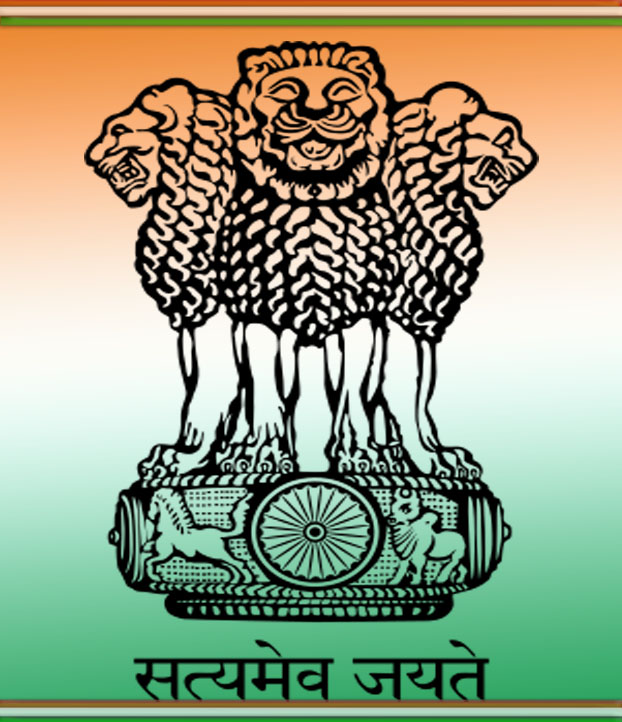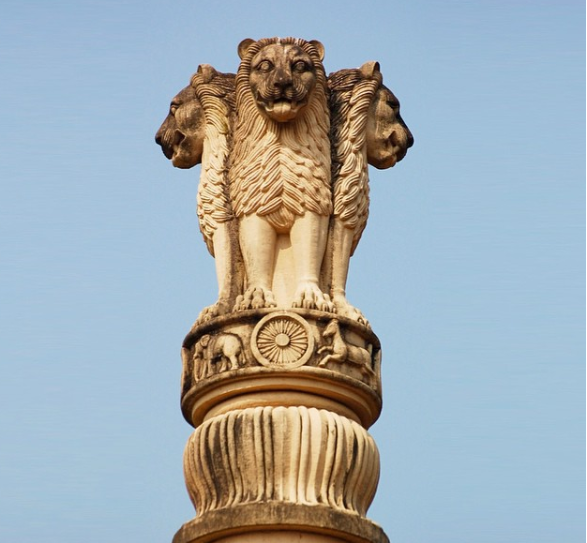National Emblem Of India | Satyameva Jayate

The national emblem of India is a replica of the Lion at Sarnath, near Varanasi in Uttar Pradesh. The Lion Capital was erected in the third century BC by Emperor Ashoka to mark the spot where the Buddha first proclaimed his gospel of peace and emancipation. The national emblem is thus symbolic of contemporary India’s reaffirmation of its ancient commitment to world peace and goodwill.
The four lions (one hidden from view), symbolizing power, courage, and confidence, rest on a circular abacus. The abacus is girded by four smaller animals, that are considered guardians of the four directions: the lion of the north, the elephant of the east, the horse of the south, and the bull of the west. The abacus rests on a lotus in full bloom, exemplifying the fountainhead of life and creative inspiration. The motto ‘Satyameva Jayate‘ inscribed below the emblem in Devanagari script means ‘truth alone triumphs.
It was adopted on 26 January 1950, the day that India became a republic.
The state emblem adopted by the Government of India has only three lions visible, the fourth being hidden from view. The wheel appears in relief in the center of the abacus with a bull on the right and a horse on the left and the outlines of the other wheels on the extreme right and left. The bell-shaped lotus has been omitted.
Suggested Read: National Flag Of India
Symbolism
It is symbolic of India’s reaffirmation of its ancient commitment to world peace and goodwill. In the original, there are four lions, standing back to back, mounted on an abacus with a frieze carrying sculptures in high relief of an elephant, a galloping horse, a bull, and a lion separated by intervening wheels over a bell-shaped lotus.
The four animals symbolize guardians of the four directions. The four lions symbolize courage, power, and confidence, and the lotus base represents the fountain of life. At the bottom of the national emblem, the Indian national motto ‘Satyameva Jayate’ is inscribed in Devanagari script which means ‘truth alone triumphs.’

Suggested Read: National Song Of India
History
The history behind the National Emblem’s inspiration dates back to the 3rd Century BC. The third Mauryan emperor, Ashoka was a great conqueror and he established the first true empire in India.
National Emblem of India is a replica of the Lion Capital of Sarnath. The lion capital is a sculpture of four lions standing back to back. It was placed on the top of the Ashoka Pillar at Sarnath by Emperor Ashoka, in 250 BCE.
The Capital is made from single sandstone. The four lions are mounted on an abacus with sculptures of an elephant, horse, bull, and lion separated by intervening spoke chariot wheels. The whole sculpture was sitting on a bell-shaped lotus.
The ‘Wheel of Dharma’ was known as Ashoka Chakra with 24 spokes and is visible in today’s Flag of India, with a navy blue color and white background.

Suggested Read: National Anthem Of India
Significance
Emperor Ashoka embraced Buddhism after witnessing the endless bloodshed his quests wrought over the country. Thereafter, instead of conquests and wars, he made non-violence, spiritualism, compassion, and peaceful co-existence the cornerstones of his administration.
He erected a number of sculptures and stone carvings throughout his kingdom to preach the tenets of Buddhism among his people. The Lion Capital was erected by Mauryan Emperor Ashoka during the year 250 BC to mark the spot where Buddha imparted his knowledge of Dharma to his five disciples, who in turn spread the great monk’s teachings all over the world. The Emperor erected many such other pillars, but most of them contain a single animal on top.
Suggested Read: National Symbols Of India






